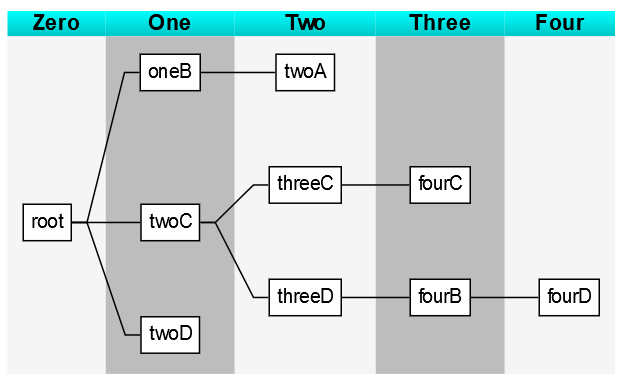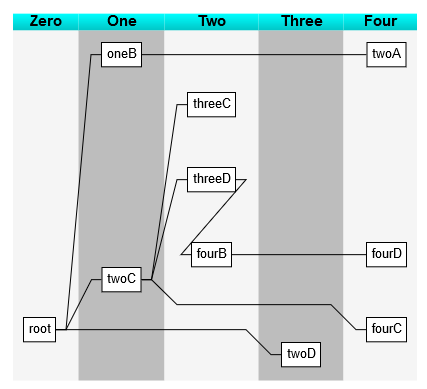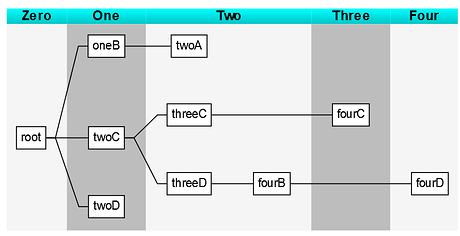OK, let’s get rid of that extra data.layer property used by the custom BandedLDLayout in that sample. So the graph gets laid out normally:

Now we’ll add a data property indicating that that node/vertex, “fourB”, should go into the band that comes before its normal band:
{ key: "fourB", parent: "threeD", inPreviousBand: true },
With the following changes to BandedLDLayout, we now get:
// this controls whether the layout is horizontal and the layer bands are vertical, or vice-versa:
var HORIZONTAL = true; // this constant parameter can only be set here, not dynamically
// Perform a LayeredDigraphLayout where commitLayers is overridden to modify the background Part whose key is "_BANDS".
function BandedLDLayout() {
go.LayeredDigraphLayout.call(this);
}
go.Diagram.inherit(BandedLDLayout, go.LayeredDigraphLayout);
BandedLDLayout.prototype.assignLayers = function() {
go.LayeredDigraphLayout.prototype.assignLayers.call(this);
// now assign specific layers
var shifted = new Array(this.maxLayer+1);
var it = this.network.vertexes.iterator;
while (it.next()) {
var v = it.value;
if (v.node !== null && v.node.data.inPreviousBand) {
shifted[v.layer] = true;
}
}
var shifts = [];
var c = 0;
for (var i = 0; i < shifted.length; i++) {
shifts[i] = c;
if (shifted[i]) c++;
}
it.reset();
while (it.next()) {
var v = it.value;
v.layer += shifts[v.layer];
if (v.node !== null && v.node.data.inPreviousBand) {
v.layer++;
}
}
var extras = [false];
for (var i = 1; i < shifts.length; i++) {
extras[i] = shifts[i] > shifts[i-1];
}
this._extras = extras.reverse();
};
BandedLDLayout.prototype.commitLayers = function(layerRects, offset) {
// update the background object holding the visual "bands"
var bands = this.diagram.findPartForKey("_BANDS");
if (bands) {
var model = this.diagram.model;
bands.location = this.arrangementOrigin.copy().add(offset);
// set the bounds of each band via data binding of the "bounds" property
var arr = bands.data.itemArray;
var j = 0;
for (var i = 0; i < layerRects.length; i++) {
var itemdata = arr[j++];
if (itemdata) {
var r = layerRects[i];
if (this._extras[i]) {
i++;
r = r.copy().unionRect(layerRects[i]);
}
model.setDataProperty(itemdata, "bounds", r);
}
}
// make each band visible or not, depending on whether there is a layer for it
for (var it = bands.elements; it.next(); ) {
var idx = it.key;
var elt = it.value; // the item panel representing a band
elt.visible = idx < j;
}
}
};
// end BandedLDLayout
function init() {
var $ = go.GraphObject.make;
myDiagram = $(go.Diagram, "myDiagramDiv",
{
layout: $(BandedLDLayout,
{
direction: HORIZONTAL ? 0 : 90
}), // custom layout is defined above
"undoManager.isEnabled": true
});
myDiagram.nodeTemplate =
$(go.Node, go.Panel.Auto,
$(go.Shape, "Rectangle",
{ fill: "white" }),
$(go.TextBlock, { margin: 5 },
new go.Binding("text", "key")));
// There should be at most a single object of this category.
// This Part will be modified by BandedLDLayout.commitLayers to display visual "bands"
// where each "layer" is a layer of the tree.
// This template is parameterized at load time by the HORIZONTAL parameter.
// You also have the option of showing rectangles for the layer bands or
// of showing separator lines between the layers, but not both at the same time,
// by commenting in/out the indicated code.
myDiagram.nodeTemplateMap.add("Bands",
$(go.Part, "Position",
new go.Binding("itemArray"),
{
isLayoutPositioned: false, // but still in document bounds
locationSpot: new go.Spot(0, 0, HORIZONTAL ? 0 : 16, HORIZONTAL ? 16 : 0), // account for header height
layerName: "Background",
pickable: false,
selectable: false,
itemTemplate:
$(go.Panel, HORIZONTAL ? "Vertical" : "Horizontal",
new go.Binding("position", "bounds", function(b) { return b.position; }),
$(go.TextBlock,
{
angle: HORIZONTAL ? 0 : 270,
textAlign: "center",
wrap: go.TextBlock.None,
font: "bold 11pt sans-serif",
background: $(go.Brush, "Linear", { 0: "aqua", 1: go.Brush.darken("aqua") })
},
new go.Binding("text"),
// always bind "width" because the angle does the rotation
new go.Binding("width", "bounds", function(r) { return HORIZONTAL ? r.width : r.height; })
),
$(go.Shape,
{ stroke: null, strokeWidth: 0 },
new go.Binding("desiredSize", "bounds", function(r) { return r.size; }),
new go.Binding("fill", "itemIndex", function(i) { return i % 2 == 0 ? "whitesmoke" : go.Brush.darken("whitesmoke"); }).ofObject())
)
}
));
myDiagram.linkTemplate =
$(go.Link,
$(go.Shape)); // simple black line, no arrowhead needed
// define the tree node data
var nodearray = [
{ // this is the information needed for the headers of the bands
key: "_BANDS",
category: "Bands",
itemArray: [
{ text: "Zero" },
{ text: "One" },
{ text: "Two" },
{ text: "Three" },
{ text: "Four" },
{ text: "Five" }
]
},
// these are the regular nodes in the TreeModel
{ key: "root" },
{ key: "oneB", parent: "root" },
{ key: "twoA", parent: "oneB" },
{ key: "twoC", parent: "root" },
{ key: "threeC", parent: "twoC" },
{ key: "threeD", parent: "twoC" },
{ key: "fourB", parent: "threeD", inPreviousBand: true },
{ key: "fourC", parent: "threeC" },
{ key: "fourD", parent: "fourB" },
{ key: "twoD", parent: "root" }
];
myDiagram.model = new go.TreeModel(nodearray);
}
Note that if a node/vertex is the only one in its band and it is moved up to the previous band, the old band will be empty. By default, as you can see in the code (unchanged from the sample), it makes empty bands invisible. So in the original sample, node “fourC” was not a child of “threeC” but of “twoC”. I moved it so that the band would not become empty. Making that band empty would cause it to become invisible, resulting in “Two” and “Four” adjoining each other. You might want to do something different.



